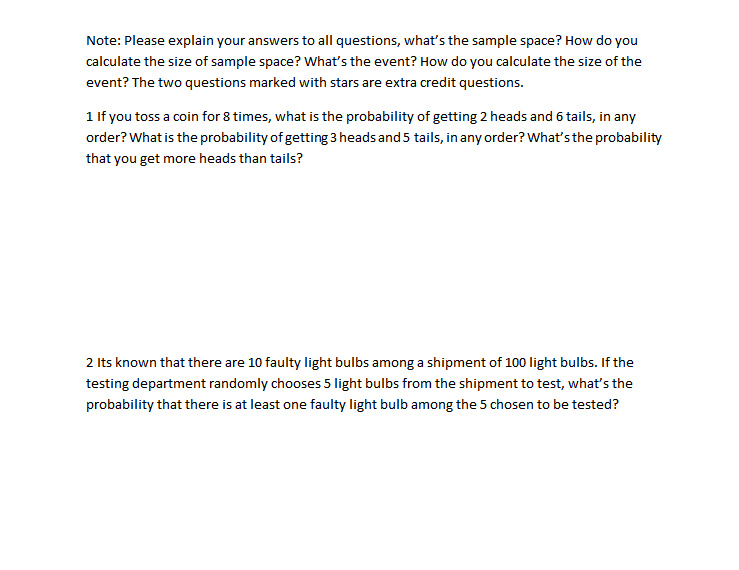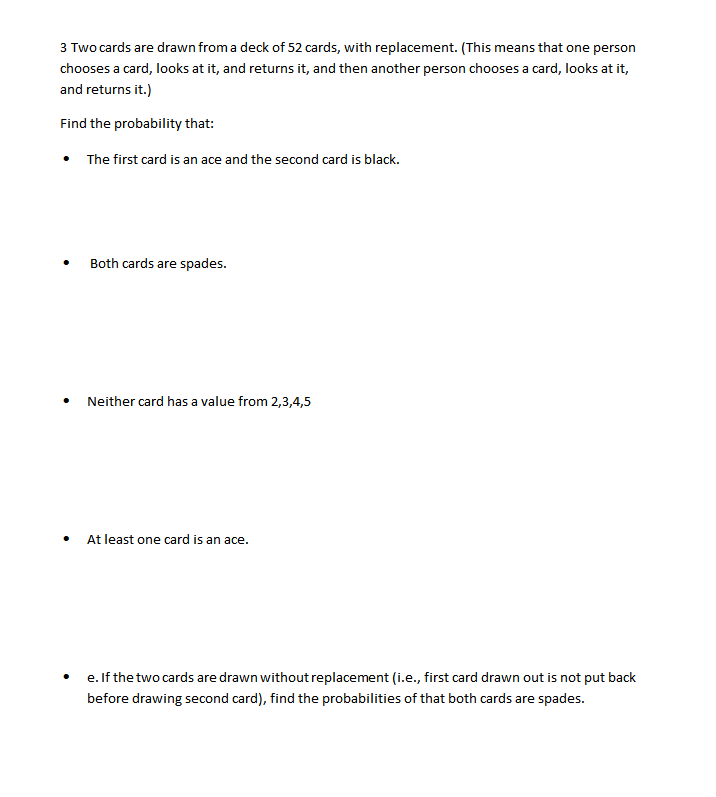Note: Please explain your answers to all questions, what's the sample space? How do you calculate the size of sample space? What's the event? How do you calculate the size of the event? The two questions marked with stars are extra credit questions. 1 If you toss a coin for 8 times, what is the probability of getting 2 heads and 6 tails, in any order? What is the probability of getting 3 heads and 5 tails, in any order? What's the probability that you get more heads than tails? 2 Its known that there are 10 faulty light bulbs among a shipment of 100 light bulbs. If the testing department randomly chooses 5 light bulbs from the shipment to test, what's the probability that there is at least one faulty light bulb among the 5 chosen to be tested? 3 Two cards are drawn from a deck of 52 cards, with replacement. (This means that one person chooses a card, looks at it, and returns it, and then another person chooses a card, looks at it, and returns it.) Find the probability that: The first card is an ace and the second card is black. Both cards are spades. Neither card has a value from 2,3,4,5 At least one card is an ace. e. If the two cards are drawn without replacement (i.e., first card drawn out is not put back before drawing second card), find the probabilities of that both cards are spades.
Note: Please explain your answers to all questions, what's the sample space? How do you calculate the size of sample space? What's the event? How do you calculate the size of the event? The two questions marked with stars are extra credit questions. 1 If you toss a coin for 8 times, what is the probability of getting 2 heads and 6 tails, in any order? What is the probability of getting 3 heads and 5 tails, in any order? What's the probability that you get more heads than tails? 2 Its known that there are 10 faulty light bulbs among a shipment of 100 light bulbs. If the testing department randomly chooses 5 light bulbs from the shipment to test, what's the probability that there is at least one faulty light bulb among the 5 chosen to be tested? 3 Two cards are drawn from a deck of 52 cards, with replacement. (This means that one person chooses a card, looks at it, and returns it, and then another person chooses a card, looks at it, and returns it.) Find the probability that: The first card is an ace and the second card is black. Both cards are spades. Neither card has a value from 2,3,4,5 At least one card is an ace. e. If the two cards are drawn without replacement (i.e., first card drawn out is not put back before drawing second card), find the probabilities of that both cards are spades.
Algebra and Trigonometry (MindTap Course List)
4th Edition
ISBN:9781305071742
Author:James Stewart, Lothar Redlin, Saleem Watson
Publisher:James Stewart, Lothar Redlin, Saleem Watson
Chapter14: Counting And Probability
Section14.CR: Chapter Review
Problem 5CC: a What is meant by an experiment? Sample space? b What is an event? c Define the probability of an...
Related questions
Question

Transcribed Image Text:Note: Please explain your answers to all questions, what's the sample space? How do you
calculate the size of sample space? What's the event? How do you calculate the size of the
event? The two questions marked with stars are extra credit questions.
1 If you toss a coin for 8 times, what is the probability of getting 2 heads and 6 tails, in any
order? What is the probability of getting 3 heads and 5 tails, in any order? What's the probability
that you get more heads than tails?
2 Its known that there are 10 faulty light bulbs among a shipment of 100 light bulbs. If the
testing department randomly chooses 5 light bulbs from the shipment to test, what's the
probability that there is at least one faulty light bulb among the 5 chosen to be tested?

Transcribed Image Text:3 Two cards are drawn from a deck of 52 cards, with replacement. (This means that one person
chooses a card, looks at it, and returns it, and then another person chooses a card, looks at it,
and returns it.)
Find the probability that:
The first card is an ace and the second card is black.
Both cards are spades.
Neither card has a value from 2,3,4,5
At least one card is an ace.
e. If the two cards are drawn without replacement (i.e., first card drawn out is not put back
before drawing second card), find the probabilities of that both cards are spades.
Expert Solution
This question has been solved!
Explore an expertly crafted, step-by-step solution for a thorough understanding of key concepts.
This is a popular solution!
Trending now
This is a popular solution!
Step by step
Solved in 5 steps with 4 images

Recommended textbooks for you

Algebra and Trigonometry (MindTap Course List)
Algebra
ISBN:
9781305071742
Author:
James Stewart, Lothar Redlin, Saleem Watson
Publisher:
Cengage Learning

College Algebra
Algebra
ISBN:
9781305115545
Author:
James Stewart, Lothar Redlin, Saleem Watson
Publisher:
Cengage Learning


Algebra and Trigonometry (MindTap Course List)
Algebra
ISBN:
9781305071742
Author:
James Stewart, Lothar Redlin, Saleem Watson
Publisher:
Cengage Learning

College Algebra
Algebra
ISBN:
9781305115545
Author:
James Stewart, Lothar Redlin, Saleem Watson
Publisher:
Cengage Learning


College Algebra (MindTap Course List)
Algebra
ISBN:
9781305652231
Author:
R. David Gustafson, Jeff Hughes
Publisher:
Cengage Learning